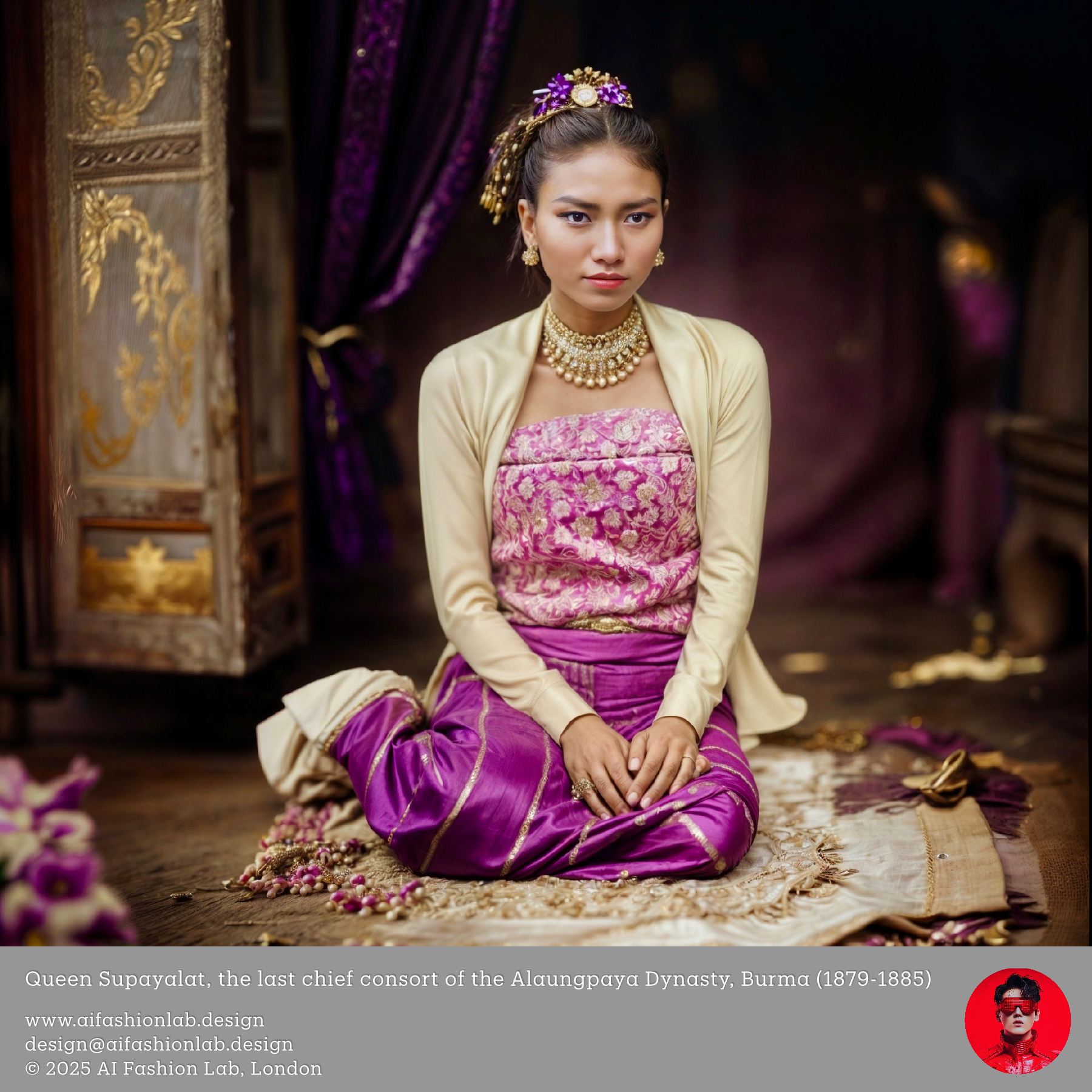Queen Supayalat: The Last Queen of Burma
Queen Supayalat: The Last Queen of Burma
พระนางสุปายาลัต: ราชินีองค์สุดท้ายแห่งพม่า
พระนางสุปายาลัต (စုဖုရားလတ်) เสด็จพระราชสมภพเมื่อวันที่ 13 ธันวาคม ค.ศ. 1859 ในเมืองมัณฑะเลย์ เป็นบุคคลสำคัญที่เปี่ยมด้วยความขัดแย้งในประวัติศาสตร์พม่า ในฐานะพระธิดาของพระเจ้ามินดงและพระนางสินพยูมาชิน (หรือที่รู้จักในนาม "พระนางช้างเผือก") พระนางสุปายาลัตได้ก้าวขึ้นสู่ตำแหน่งสำคัญในฐานะพระมเหสีของพระเจ้าธีบอ พระมหากษัตริย์องค์สุดท้ายแห่งราชวงศ์คองบอง ชีวิตของพระองค์เต็มไปด้วยความทะเยอทะยาน การชิงอำนาจทางการเมือง และความมุ่งมั่นอย่างแน่วแน่ที่จะรวมอำนาจในช่วงเวลาที่พม่ากำลังเผชิญความปั่นป่วนอย่างหนัก
รัชสมัยที่เต็มไปด้วยเลือดและการปฏิรูป
เมื่อพระเจ้ามินดงสวรรคตในปี ค.ศ. 1878 สุปายาลัตและพระเจ้าธีบอได้เสด็จขึ้นครองราชย์ท่ามกลางวิกฤตการสืบราชสมบัติ ซึ่งมีการประหารสมาชิกพระราชวงศ์หลายสิบพระองค์เพื่อสร้างความมั่นคงในอำนาจของทั้งสอง แม้พระองค์จะทรงปฏิเสธการมีส่วนเกี่ยวข้องกับเหตุการณ์ดังกล่าว แต่ประวัติศาสตร์ระบุว่าพระมารดาและเสนาบดีสำคัญบางคน เช่น อูข่อง มีบทบาทในการวางแผน
พระนางสุปายาลัตไม่ได้เป็นเพียงพระมเหสี แต่ยังทรงเป็นผู้ทรงอิทธิพลในราชสำนัก โดยทรงมีอำนาจเหนือพระเจ้าธีบออย่างชัดเจน พระองค์ได้เปลี่ยนแปลงธรรมเนียมที่มีมานานหลายศตวรรษด้วยการยืนยันให้กษัตริย์พม่าเป็นแบบคู่สมรสเดียว ซึ่งเป็นครั้งแรกและครั้งเดียวในประวัติศาสตร์ แม้การปฏิรูปนี้จะมีผลในเชิงสัญลักษณ์ที่สำคัญ แต่ก็มีราคาที่ต้องจ่าย เมื่อพระองค์ทรงประหารนางสนมชื่อไดง์คินคินที่กำลังตั้งครรภ์ ซึ่งเป็นอีกเหตุการณ์ที่สร้างชื่อเสียงในด้านความโหดร้าย
การล่มสลายของราชวงศ์
รัชสมัยของพระนางสุปายาลัตตรงกับช่วงเวลาที่ราชวงศ์คองบองเสื่อมอำนาจและการรุกรานของจักรวรรดิอังกฤษ ในปี ค.ศ. 1885 พม่าได้ตกเป็นอาณานิคมของอังกฤษ พระองค์พร้อมด้วยพระเจ้าธีบอและพระราชโอรสธิดาถูกเนรเทศไปยังเมืองรัตนคีรีในอินเดีย ทรงใช้ชีวิตในฐานะผู้ลี้ภัยที่สูญเสียแผ่นดิน แต่ยังทรงดำรงพระอิสริยยศอย่างเต็มภาคภูมิ
นักประวัติศาสตร์มักมองพระนางสุปายาลัตว่าเป็นสัญลักษณ์ของความหยิ่งทะนงและความทะเยอทะยาน ซึ่งบางคนเชื่อว่าเป็นเหตุให้ราชอาณาจักรล่มสลาย อย่างไรก็ตาม บางส่วนมองพระองค์ว่าเป็นผู้นำที่เฉลียวฉลาดและเด็ดเดี่ยว ซึ่งสามารถจัดการกับราชสำนักที่ผู้ชายครอบงำได้อย่างน่าทึ่ง การพยายามปฏิรูปธรรมเนียมราชวงศ์ โดยเฉพาะการยุติระบบหลายมเหสี เป็นเครื่องยืนยันถึงวิสัยทัศน์ของพระองค์ แม้ว่าวิธีการอาจรุนแรงก็ตาม
มรดกทางประวัติศาสตร์
พระนางสุปายาลัตเสด็จกลับพม่าในช่วงบั้นปลายพระชนม์ชีพ และประทับอยู่ที่กรุงย่างกุ้งจนเสด็จสวรรคตเมื่อวันที่ 24 พฤศจิกายน ค.ศ. 1925 พระศพถูกฝังที่สุสานกันดอว์มิน พระองค์ทรงทิ้งมรดกทางประวัติศาสตร์ที่ยังคงก่อให้เกิดข้อถกเถียง
สำหรับบางคน พระนางสุปายาลัตเป็นสัญลักษณ์ของความโหดร้ายและความหยิ่งทะนง ซึ่งเป็นตัวแทนของสุภาษิตพม่า "ผู้หญิงสามารถทำให้แผ่นดินล่มจมได้" (မိန်းမဖျက် ပြည်ပျက်) อย่างไรก็ตาม สำหรับบางคน พระองค์ทรงเป็นบุคคลที่น่าเห็นใจ—เป็นราชินีผู้เฉลียวฉลาดและเด็ดเดี่ยวที่ต้องเผชิญความท้าทายครั้งใหญ่ในประวัติศาสตร์ เรื่องราวของพระองค์เป็นเครื่องเตือนใจถึงความซับซ้อนของบทบาทสตรีในประวัติศาสตร์
Queen Supayalat: The Last Queen of Burma
Queen Supayalat (စုဖုရားလတ်), born on 13 December 1859 in Mandalay, stands as one of the most controversial figures in Burmese history. As the daughter of King Mindon and Queen Hsinbyumashin (also known as the Lady of the White Elephant), she rose to prominence through her marriage to her half-brother Thibaw, the last monarch of the Konbaung dynasty. Her life was marked by ambition, political intrigue, and an unyielding determination to consolidate power during one of Burma's most tumultuous periods.
A Reign Marked by Blood and Reform
When King Mindon passed away in 1878, Supayalat and Thibaw ascended the throne amid a bloody succession crisis. To secure their rule, she is widely believed to have sanctioned the execution of dozens of royal family members—a massacre that has cast a long shadow over her legacy. Though she consistently denied involvement, historians suggest the plan may have been orchestrated by her mother and key court ministers.
Supayalat was no mere consort; she was a formidable force in the court, wielding significant influence over Thibaw, who was often seen as a passive ruler. She broke with centuries of tradition by insisting on monogamy, refusing to allow her husband to take additional consorts. This was an unprecedented reform in Burmese royal history, though it came at a cost. Her fierce jealousy led to the execution of Daing Khin Khin, a secret concubine carrying Thibaw's child, an act that further cemented her reputation for ruthlessness.
The Fall of a Dynasty
Supayalat’s reign coincided with the decline of the Konbaung dynasty and the encroachment of British imperial forces. By 1885, Burma had fallen to British rule, and Supayalat, Thibaw, and their children were exiled to Ratnagiri in India. Stripped of her kingdom, she spent years in exile, mourning the loss of her homeland while maintaining her regal bearing.
Historians often portray Supayalat as a symbol of arrogance and ambition—qualities that, some argue, hastened the kingdom’s fall. Yet others view her as a shrewd and determined leader who navigated a male-dominated court with remarkable tenacity. Her efforts to modernise royal traditions, particularly her challenge to polygamy, stand as a testament to her vision for reform, even if her methods were unforgiving.
Legacy
Supayalat returned to Burma in her later years, settling in Rangoon, where she lived until her death on 24 November 1925. She was buried in the Kandawmin Garden Mausolea, leaving behind a legacy that continues to provoke debate.
To some, she remains a symbol of cruelty and excess, embodying the Burmese proverb: "A woman can bring ruin to a kingdom" (မိန်းမဖျက် ပြည်ပျက်). To others, she is a tragic figure—an intelligent and strong-willed queen caught in the crossfire of history. Her story is a poignant reminder of the complexities of leadership and the personal sacrifices that often accompany power.
#aifashionlab #AI #aiartist #aiart #aifashion #aifashiondesign #aifashionstyling #aifashiondesigner #fashion #fashionhistory #historyoffashion #fashionstyling #fashionphotography #digitalfashion #digitalfashiondesign #digitalcostumedesign #digitaldesign #digitalaiart #promptography #promptographer #prompts #fashionpromptography



